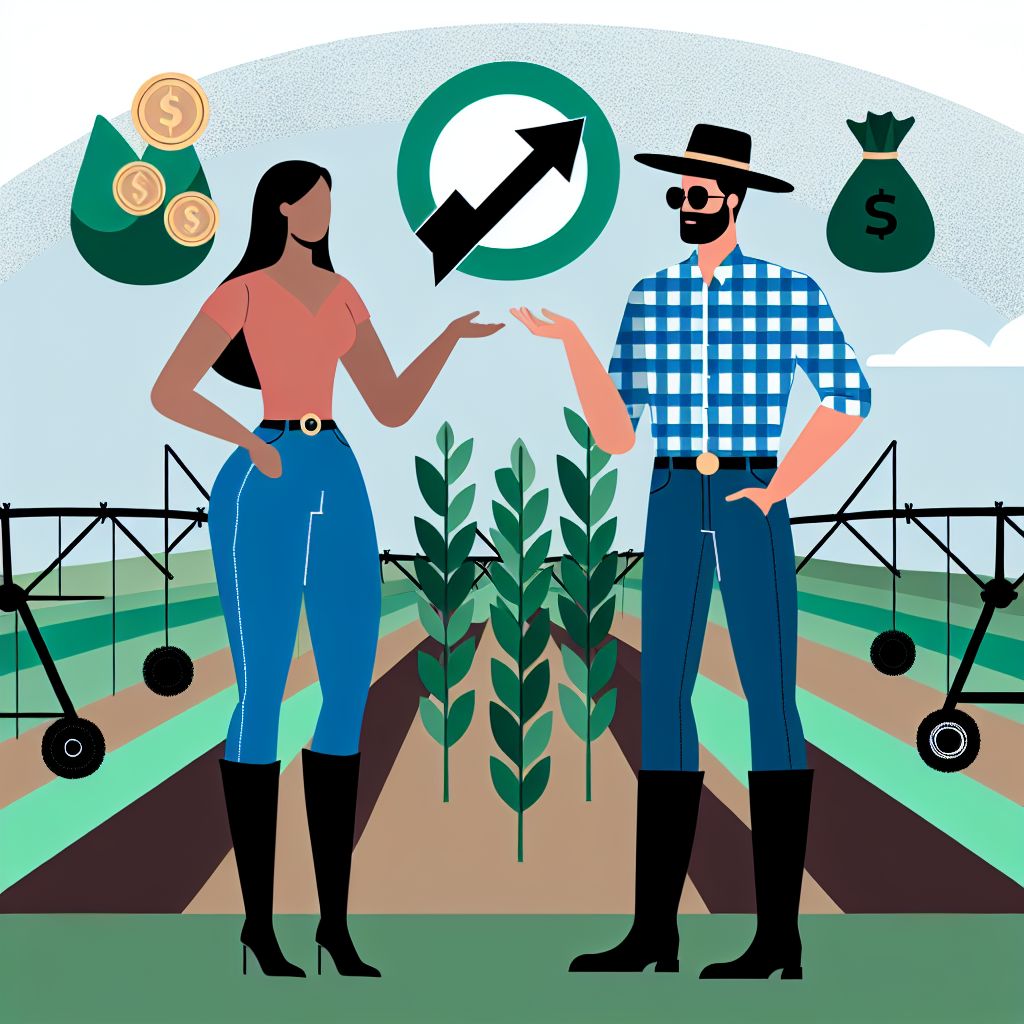Overview of Sustainable Agriculture
Definition of Sustainable Agriculture
Sustainable agriculture refers to farming practices that meet current food needs.
It aims to improve environmental health, economic profitability, and social equity.
This approach integrates three main goals: environmental stewardship, economic viability, and community well-being.
Furthermore, sustainable agriculture emphasizes resource conservation and efficiency.
Importance of Sustainable Agriculture
Sustainable agriculture plays a critical role in food security.
It helps reduce the negative impacts of conventional farming methods.
This farming approach protects natural ecosystems and enhances biodiversity.
Moreover, it supports rural economies by providing stable income for farmers.
Principles of Sustainable Agriculture
- Soil health and fertility maintenance.
- Water conservation and efficient use.
- Diverse crop rotations and integrated pest management.
- Reduced chemical inputs and synthetic fertilizers.
Adopting these principles promotes resilience against climate change.
Additionally, sustainable agriculture contributes to the long-term health of the planet.
Challenges in Sustainable Agriculture
Farmers often face various obstacles when adopting sustainable practices.
Financial limitations can hinder the transition from conventional methods.
Moreover, a lack of knowledge and technical support can pose significant challenges.
Market access for sustainably produced goods remains a persistent issue.
Addressing these challenges is essential for successful implementation.
Transform Your Agribusiness
Unlock your farm's potential with expert advice tailored to your needs. Get actionable steps that drive real results.
Get StartedPrinciples of Sustainable Agriculture: Balancing Ecological Health and Economic Viability
Understanding Sustainable Agriculture
Sustainable agriculture focuses on producing food responsibly.
It prioritizes ecological health while maintaining economic viability.
This approach promotes long-term farming practices.
Ecological Balance
Sustainable agriculture maintains ecological balance in various ecosystems.
It enhances biodiversity through diverse crop rotations.
Additionally, soil health improves, leading to increased resilience.
This practice minimizes harmful environmental impacts.
Economic Viability
Farmers benefit from sustainable practices financially.
By reducing reliance on synthetic inputs, costs decrease.
Investing in local markets can enhance profitability.
Moreover, sustainable methods often yield higher premiums for products.
Meeting Current and Future Food Needs
This holistic approach meets today’s food demands effectively.
Furthermore, it ensures resources remain for future generations.
Sustainable practices can adapt to climate change challenges.
Hence, they promote long-term agricultural productivity.
Implementing Sustainable Strategies
- Crop rotation helps prevent soil depletion.
- Integrating livestock improves nutrient cycling.
- Cover cropping protects against erosion.
- Organic farming reduces chemical usage.
All these practices foster ecological and economic benefits.
Community Engagement and Education
Engaging with local communities strengthens sustainable agriculture.
Educating farmers about best practices promotes innovation.
Sharing knowledge creates a supportive network for sustainability.
This collaborative approach can lead to shared success.
Crop Rotation Strategies
Enhancing Soil Fertility
Crop rotation boosts soil fertility through diversity.
This technique reduces nutrient depletion in the land.
Different plants foster various soil microorganisms.
Legumes, for instance, enrich the soil with nitrogen.
Showcase Your Farming Business
Publish your professional farming services profile on our blog for a one-time fee of $200 and reach a dedicated audience of farmers and agribusiness owners.
Publish Your ProfileIn contrast, deep-rooted crops can break up compact soil.
Furthermore, rotating crops can prevent soil erosion.
Healthy soil supports higher yields over time.
As a result, farmers gain more profits annually.
Pest Management
Effective pest management is crucial in agriculture.
Crop rotation disrupts pest life cycles significantly.
Certain pest populations thrive on specific crops.
By changing crops regularly, farmers minimize these pests.
This approach reduces reliance on chemical pesticides.
Consequently, it promotes a healthier ecosystem overall.
Farmers can maintain better crop health through this method.
Ultimately, the yield increases while costs decrease.
Implementing Crop Rotation
A well-planned rotation schedule is essential.
Farmers should consider local climate and soil conditions.
Choosing compatible crops is also vital for success.
Consulting agricultural experts can optimize crop selection.
Additionally, keeping records helps refine the rotation process.
Engaging with community initiatives promotes shared knowledge.
Through collaboration, farmers can learn from each other’s experiences.
This network strengthens sustainable practices in the region.
Discover More: Nutrient Management for Maximizing Crop Yields in the USA
Organic Farming Practices: Benefits for Soil and Ecosystem Health
Improved Soil Fertility
Organic farming enhances soil fertility through natural methods.
Cover cropping nourishes the soil while preventing erosion.
Crop rotation helps in balancing nutrient levels effectively.
Additionally, composting enriches the soil with organic matter.
Enhanced Biodiversity
Organic farms often support a diverse range of species.
This diversity contributes to a balanced ecosystem.
Beneficial insects thrive in environments free from chemicals.
Moreover, diverse crops can reduce pest populations naturally.
Water Management
Effective management of water is crucial in organic farming.
Practices such as mulching retain soil moisture efficiently.
Farmers can also utilize rainwater harvesting techniques.
These methods help reduce reliance on irrigation.
Promotion of Natural Pest Control
Organic farming encourages natural pest control methods.
Beneficial insects, such as ladybugs, combat harmful pests.
Additionally, planting habitats for these insects increases their populations.
This reduces the need for synthetic pesticides considerably.
Reduction of Chemical Inputs
Organic practices minimize the use of harmful chemicals.
This approach leads to healthier ecosystems and food supplies.
Without synthetic fertilizers and pesticides, soil health improves.
Showcase Your Farming Business
Publish your professional farming services profile on our blog for a one-time fee of $200 and reach a dedicated audience of farmers and agribusiness owners.
Publish Your ProfileConsequently, organic produce often shows higher nutritional value.
Soil-Based Carbon Sequestration Benefits
Organic farming practices promote carbon sequestration in soil.
Healthy soils can capture and store significant amounts of carbon.
This process contributes to combating climate change effectively.
Therefore, organic methods benefit both farms and the environment.
Learn More: Greenhouse Cultivation for Profitable Specialty Crops in the USA
Agroforestry: Integrating Trees for Biodiversity and Land Productivity
Introduction to Agroforestry
Agroforestry combines agriculture and forestry practices.
This method enhances biodiversity in the farming landscape.
Farmers across the globe adopt agroforestry for various benefits.
Moreover, integrating trees into agricultural fields supports multiple crops.
Benefits of Agroforestry
Agroforestry offers several economic advantages for farmers.
- It improves soil fertility through organic matter.
- Trees provide shade that protects crops from extreme weather.
- Diverse planting reduces pest outbreaks and diseases.
Furthermore, agroforestry contributes to carbon sequestration.
This helps mitigate climate change effects on agriculture.
Enhancing Biodiversity
Integrating trees fosters a diverse ecosystem on farms.
A richer biodiversity enhances pollination and pest control.
Additionally, it creates habitats for various species.
This, in turn, strengthens the resilience of the agricultural system.
Strategies for Implementation
Successful implementation of agroforestry requires careful planning.
- Select appropriate tree species for local conditions.
- Plan the layout to maximize sunlight and space for crops.
- Incorporate community knowledge in decision-making.
Moreover, training farmers on agroforestry techniques is crucial.
This ensures sustainable practices and long-term success.
Case Studies and Success Stories
Success stories illustrate the potential of agroforestry.
One example is the Kenyan farmer Michael Otieno.
He integrated indigenous trees into his maize fields.
This improved soil health and increased yields significantly.
In Brazil, agroforestry in coffee plantations boosted profits.
Farmers reported both environmental and economic benefits.
Discover More: Crop Disease Management for Reducing Costs in Farm Operations

Conservation Tillage Techniques
Understanding Conservation Tillage
Conservation tillage refers to farming practices that leave soil undisturbed.
This method effectively reduces soil erosion and enhances moisture retention.
Farmers implement various strategies to achieve these benefits.
Methods of Conservation Tillage
Several techniques exist within the conservation tillage framework.
No-till farming involves planting crops directly into undisturbed soil.
This approach minimizes the disruption of soil structure.
Reduced tillage, on the other hand, involves limited soil disturbance.
Strip-tillage focuses on tilling only narrow strips where crops will grow.
Each method has its advantages depending on specific farm conditions.
Reducing Soil Erosion
Soil erosion significantly impacts agricultural productivity.
Conservation tillage creates a protective layer of crop residue on the soil surface.
This barrier shields the soil from wind and water erosion.
As a result, more nutrients remain in the soil for crops.
Showcase Your Farming Business
Publish your professional farming services profile on our blog for a one-time fee of $200 and reach a dedicated audience of farmers and agribusiness owners.
Publish Your ProfileMoreover, it fosters healthier soil ecosystems that support plant growth.
Retaining Soil Moisture
Soil moisture retention is critical for crop health and yield.
Conservation tillage practices help keep moisture within the soil.
When the soil is undisturbed, it retains more rainfall and dew.
This practice is especially beneficial in dry climates or drought-prone areas.
Farmers can receive higher yields through effective moisture management.
Environmental Benefits of Conservation Tillage
Conservation tillage offers environmental benefits as well.
It enhances carbon sequestration by maintaining soil structure.
Additionally, it promotes biodiversity in soil microbial communities.
Ultimately, these methods support sustainable farming practices.
Farmers improve both land and ecosystem health through conservation tillage.
Explore Further: Best Crop Rotation Practices for Long-Term Soil Health
Water Management Strategies
Efficient Irrigation Techniques
Efficient irrigation maximizes water use for crops.
It reduces waste and increases yield quality.
Drip irrigation delivers water directly to plant roots.
This technique minimizes evaporation and runoff.
Additionally, it conserves water resources significantly.
Furthermore, selecting the right irrigation system is crucial.
Consider soil type and crop needs when choosing.
Regular maintenance of irrigation systems enhances efficiency.
Monitoring soil moisture levels optimizes water application.
Moreover, scheduling irrigation during cooler parts of the day helps.
Rainwater Harvesting Systems
Rainwater harvesting captures and stores rainfall for use.
This method reduces reliance on traditional water sources.
First, install collection systems like gutters and tanks.
Effective systems can supply water for irrigation.
Additionally, filter the collected rainwater for quality.
Implementing rain gardens can improve water absorption in fields.
These gardens also support local biodiversity and ecology.
Moreover, rainwater harvesting decreases erosion risks.
Lastly, educate farm workers on the benefits of this method.
Integrating Technology in Water Management
Technology enhances water management practices effectively.
Utilizing soil moisture sensors informs irrigation decisions.
These tools provide real-time data for better planning.
Smart irrigation systems automate water delivery based on need.
Additionally, using weather forecasting tools aids in planning.
Farmers can optimize their irrigation schedules accordingly.
Data analytics can identify inefficiencies in water use.
Implement these technologies for improved sustainability.
Consequently, farmers will increase profitability over time.
Showcase Your Farming Business
Publish your professional farming services profile on our blog for a one-time fee of $200 and reach a dedicated audience of farmers and agribusiness owners.
Publish Your ProfilePest Management Approaches
Understanding Integrated Pest Management
Integrated Pest Management (IPM) offers an effective strategy for managing pests sustainably.
This approach combines various management techniques to lower reliance on chemical pesticides.
Moreover, IPM promotes economic and environmental sustainability in agriculture.
Key Components of IPM
IPM includes several essential components that work together effectively.
- Monitoring pest populations regularly helps in timely intervention.
- Identifying pests accurately ensures the best management practices are applied.
- Implementing cultural practices can reduce pest infestation risks.
- Utilizing biological controls, such as natural predators, can help manage pest populations.
Benefits of Integrated Pest Management
Implementing IPM leads to various benefits for farmers and the environment.
- Reduced chemical pesticide usage enhances farm sustainability.
- Lowering pesticide resistance prolongs the effectiveness of existing products.
- Improving biodiversity supports ecosystem health.
- Enhancing crop yields reduces economic losses due to pest damage.
Procedures for Implementing Integrated Pest Management
Several practical steps facilitate the successful implementation of IPM on farms.
- Start by assessing the pest situation through field observations.
- Gather data on pest life cycles and populations for informed decisions.
- Set action thresholds to determine when pest control measures are necessary.
- Choose the appropriate pest management strategies based on the gathered information.
Examples of Successful Integrated Pest Management Applications
Many farmers have successfully implemented IPM practices, yielding impressive results.
For example, Emily Carter in Oregon reduced her pesticide usage by 40% while maintaining crop yields.
Her approach involved using beneficial insects and modifying planting schedules.
Similarly, the Rodriguez Family Farm showcased significant improvements in soil health through IPM adoption.
Additional Resources
Financial profitability of diversified farming systems: A global meta …
Exploring the Potential for Water-Limited Agriculture in the San …




